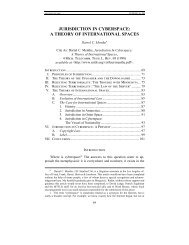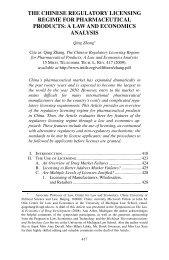Fracking Patents - Michigan Telecommunications and Technology ...
Fracking Patents - Michigan Telecommunications and Technology ...
Fracking Patents - Michigan Telecommunications and Technology ...
- No tags were found...
You also want an ePaper? Increase the reach of your titles
YUMPU automatically turns print PDFs into web optimized ePapers that Google loves.
Spring 2013] <strong>Fracking</strong> <strong>Patents</strong> 329make another attempt at abrogation have surfaced in Congress from time totime. 334 But to date, none have succeeded.Given state immunity, universities should have much more freedom toconduct basic research using a patented invention, even if the research involvesmaking patented compounds. Materials received via a license couldbe more restricted, but one might argue that the damages flowing from abreach of such a license would be minimal due to the inability to collectdamages in court. 335One interesting twist in this area of the law is that universities couldpotentially face a greater likelihood of injunction. While the traditional injunctiontest would not be applicable due to state immunity, the doctrine ofEx Parte Young 336 could be used to stop prospective infringement. 337 ExParte Young permits a government official to be enjoined for a violation offederal law, including patent infringement. 338 It is unclear whether Ex ParteYoung would apply when the traditional injunction test under eBay is notsatisfied, but there is at least an argument for different treatment. In anycase, courts have been reluctant to impose an injunction on university officialswhen they have not closely acted to support the infringement. 339An open question regarding state governments <strong>and</strong> patents is whetherthe Constitution provides an additional litigation pathway under the takingsclause. As noted above, there is still debate about the extent to which patentsare Fifth Amendment (extended to state governments under the FourteenthAmendment) property. If they are so characterized, state universities couldtheoretically be sued in state court for a taking of property or inverse condemnationrather than patent infringement. 340 While liability for such a caseis not guaranteed <strong>and</strong> depends very much on how a state waives its sovereignimmunity for takings claims, it is a consideration that should be incorporatedinto the assessment of flexibility.334. Id. at 560–61.335. See, e.g., Bowers v. Baystate Techs., Inc., 320 F.3d 1317, 1325–26 (Fed. Cir. 2003)(noting that one might elect to efficiently breach a license that prevented a use not otherwiseprotected under law <strong>and</strong> pay minimal damages).336. Ex parte Young, 209 U.S. 123 (1908).337. Frew ex rel. Frew v. Hawkins, 540 U.S. 431, 437 (2004).338. Pennington Seed, Inc. v. Produce Exch. No. 299, 457 F.3d 1334, 1341 (Fed. Cir.2006).339. Id. at 1342–43; Wesley D. Greenwell, Note, State Immunity from Patent InfringementLawsuits: Inverse Condemnation as an Alternative Remedy, 63 S.C. L. REV. 975, 984(2012).340. Daniel R. Cahoy, Patent Fences <strong>and</strong> Constitutional Fence Posts: Property Barriersto Pharmaceutical Importation, 15 FORDHAM INTELL. PROP. MEDIA & ENT. L.J. 623, 676–76(2005) (describing state liability for takings of patent rights <strong>and</strong> listing cases); Greenwell,supra note 339, at 998–99 (advocating the use of state takings claims as an alternative tosubjecting states to federal patent infringement actions).






